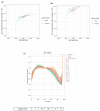Whole-Genome Sequencing Can Identify Clinically Relevant Variants from a Single Sub-Punch of a Dried Blood Spot Specimen
- PMID: 37754778
- PMCID: PMC10532340
- DOI: 10.3390/ijns9030052
Whole-Genome Sequencing Can Identify Clinically Relevant Variants from a Single Sub-Punch of a Dried Blood Spot Specimen
Abstract
The collection of dried blood spots (DBS) facilitates newborn screening for a variety of rare, but very serious conditions in healthcare systems around the world. Sub-punches of varying sizes (1.5-6 mm) can be taken from DBS specimens to use as inputs for a range of biochemical assays. Advances in DNA sequencing workflows allow whole-genome sequencing (WGS) libraries to be generated directly from inputs such as peripheral blood, saliva, and DBS. We compared WGS metrics obtained from libraries generated directly from DBS to those generated from DNA extracted from peripheral blood, the standard input for this type of assay. We explored the flexibility of DBS as an input for WGS by altering the punch number and size as inputs to the assay. We showed that WGS libraries can be successfully generated from a variety of DBS inputs, including a single 3 mm or 6 mm diameter punch, with equivalent data quality observed across a number of key metrics of importance in the detection of gene variants. We observed no difference in the performance of DBS and peripheral-blood-extracted DNA in the detection of likely pathogenic gene variants in samples taken from individuals with cystic fibrosis or phenylketonuria. WGS can be performed directly from DBS and is a powerful method for the rapid discovery of clinically relevant, disease-causing gene variants.
Keywords: DNA sequencing; cystic fibrosis; dried blood spots; newborn screening; phenylketonuria; whole genome sequencing.
Conflict of interest statement
David J. McBride, Claire Fielding, Taksina Newington, Alexandra Vatsiou, Harry Fischl, Maya Bajracharya, Vicki S. Chambers, Louise Fraser, Pauline A. Fujita, Jennifer Becq, Zoya Kingsbury, and Mark T. Ross are either current or previous full-time employees of Illumina Inc. Stuart J. Moat and Sian Morgan declare no conflicts of interest.
Figures






References
-
- Gross A.M., Ajay S.S., Rajan V., Brown C., Bluske K., Burns N.J., Chawla A., Coffey A.J., Malhotra A., Scocchia A., et al. Copy-number variants in clinical genome sequencing: Deployment and interpretation for rare and undiagnosed disease. Anesth. Analg. 2018;21:1121–1130. doi: 10.1016/j.cancergen.2018.04.058. - DOI - PMC - PubMed
LinkOut - more resources
Full Text Sources

